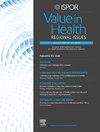在分散的卫生系统中,预防疫苗时代COVID-19的疾病和经济负担:阿根廷案例
IF 1.5
Q3 HEALTH CARE SCIENCES & SERVICES
引用次数: 0
摘要
在实施国家疫苗接种计划之前,COVID-19对阿根廷健康和经济结果的影响尚未得到充分表征。本研究旨在估计COVID-19在阿根廷成年人口中的健康和经济负担。方法采用国家COVID-19监测数据集进行回顾性观察性研究,评估:(1)临床负担,包括发病率、死亡率和根据世界卫生组织标准按严重程度分类的住院模式;(2)经济负担;(3)年的生命损失。疾病成本分析用于估计每位COVID-19患者的成本,以2023年美元表示。分析时间为2020年3月至2021年6月,在将疫苗接种作为COVID-19国家战略计划引入之前。结果在研究期间,阿根廷成年人群中COVID-19的发病率为每10万人11 490.2例。与该地区许多其他国家一样,大多数病例被归类为轻度(95%),其次是4%的严重病例(需要住院治疗)和1%的危重病例(入住重症监护病房)。每10万人失去的年龄标准化寿命从20至29岁年龄组的58.6年急剧增加到60至69岁年龄组的576.1年。与COVID-19相关的总成本为1.37亿美元,从轻度病例的244美元到危重病例的791美元不等。关于卫生部门,社会保障部门的总成本较高,占总成本的近51%,主要是因为该部门的健康覆盖率最高。在疫苗广泛使用之前,COVID-19严重影响了阿根廷的公共卫生和经济。这些发现可以帮助决策者做出明智的选择和有效分配资源,以加强有关监测、预防、治疗和对社区卫生的潜在长期影响的未来国家战略。本文章由计算机程序翻译,如有差异,请以英文原文为准。
Disease and Economic Burden of COVID-19 in the Prevaccine Era in a Fragmented Health System: The Argentine Case
Objectives
The impact of COVID-19 in Argentina’s health and economic outcomes before the implementation of the national vaccination plan has not been fully characterized. This study aimed to estimate the health and economic burden of COVID-19 in the adult population in Argentina.
Methods
We conducted a retrospective observational study using a national COVID-19 surveillance data set to assess (1) clinical burden, including incidence rates, mortality rates, and patterns of hospitalization categorized by severity based on the World Health Organization criteria; (2) economic burden; and (3) years of life lost. The cost of illness analysis was used to estimate the cost per patient with COVID-19, expressed in 2023 US dollars ($). The analyzed period was from March 2020 to June 2021, before the introduction of the vaccination as a national strategic plan for COVID-19.
Results
During the study period, the incidence rate of COVID-19 among the adult population in Argentina was 11 490.2 cases per 100 000 persons. As in many other countries in the region, most cases were classified as mild (95%), followed by 4% severe cases (requiring hospitalization) and 1% critical cases (intensive care unit [ICU] admission). The age-standardized years of life lost per 100 000 persons increased steeply from 58.6 in the 20 to 29 age group to 576.1 in the 60 to 69 age group. The total cost associated with COVID-19 was $1370 million, ranging from $244 in mild cases to $791 in critical cases. Concerning the health sectors, a higher total cost is observed in the social security sector, accounting for nearly 51% of the total costs, mainly because it has the highest rate of health coverage.
Conclusions
Before the vaccines were widely used, COVID-19 significantly strained Argentina’s public health and economy. These discoveries can aid policy makers in making well-informed choices and distributing resources efficiently to enhance future national strategies concerning surveillance, prevention, treatment, and potential long-term impacts on community health.
求助全文
通过发布文献求助,成功后即可免费获取论文全文。
去求助
来源期刊

Value in health regional issues
Pharmacology, Toxicology and Pharmaceutics-Pharmacology, Toxicology and Pharmaceutics (miscellaneous)
CiteScore
2.60
自引率
5.00%
发文量
127
 求助内容:
求助内容: 应助结果提醒方式:
应助结果提醒方式:


